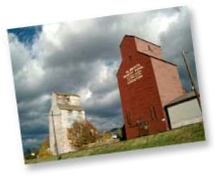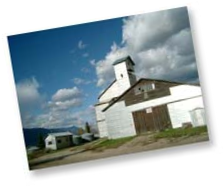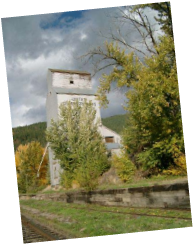The Grain Elevators
We drive by them every day and perhaps our entire lives without giving any thought as to their present day value. I’m not talking about their lumber value either. Towering above most buildings set against the backdrop of a lush rich valley are our grain elevators located in the heart of town and on the outskirts of town and in the satellite community of Wynndel.
They may not be covered bridges that are prized by easterners and their visitors. However, they are our western heritage, proudly standing out as reminders of those people who worked the soil to produce nourishment for our country’s people.
Grain elevators are a reminder of a town – our town, whose people quietly went about taking care of each other and the land. These elevators represent the values still found in our community, values that support the family, community, nature and individuality. Very few of these icons in Canada have survived. Our elevators still stand. It says something about us. I believe it tells of our resilience and of a way of life that is inherent in our cherished lifestyle. Yes, times have changed and so will the use of these grain elevators in order to continue standing as symbols of our heritage. Next time you drive by our grain elevators proudly nod in acknowledgment of their important role within our community. Also, promise to assist in their preservation, because in doing so you are agreeing to help preserve our community’s lifestyle.
Tammy Hardwick manager of the Creston and District Museum shared the following information with me via email: “The grain elevators were built in 1935 and 1936, with the red one being the first. The Wynndel grain elevator was built at about the same time, 1936 or 1937. They were built to accommodate the wheat and grain crops expected from the Creston flats once they were reclaimed, a project that also took place in 1935. Farmers sold their grain to the elevator, which then distributed it to markets in other parts of the country and probably around the world…essentially, the same principle as any of the local packing sheds. The Canadian Wheat Board set quotas for the wheat farmers; they could only sell a certain number of bushels per acre to the elevators. Unfortunately for local farmers, the yield per acre was usually far higher than that quota, which meant they had a lot of wheat that they had to sell locally, or not at all. This prompted many farmers to switch to other crops – White Dutch Clover, alfalfa, etc The Christensons built their own elevator in response (that’s the one on Devon Street, below the Museum).”
In a telephone conversation I had last November with Irmi Critcher of the B.C. Grain Producers Association I learned that the old style grain elevators are declining at a rapid rate across the country to be replaced by “state of the art” buildings. She said there are only a few regions in BC that had grain elevators. Irmi said it seems that the grain elevators that survive do so because the community values them and people find ways to change their use to something that is needed in the community. Dawson Creek has renovated their grain elevator into an art gallery and the other is part of a historical park.
Taken from Louis Post
Dispatch 1997
Kansas City Star
”As everyone who has driven across the Great Plains remembers, the elevators are the lighthouses of the prairies, the visual parentheses that bracket each stage of the journey. Leave one small town and look ahead to the next grain elevator, miles away. Arrive there and, almost reassuringly, another elevator materializes in the distance. Then another and another. Linda Laird and her husband, Larry Haney, have a passion for grain elevators. They collect them – on paper and on film. Traveling from Texas to the Canadian border, Missouri to Utah, they’ve taken 1,500 photographs, talked to hundreds of people, dug deep into old records.”




